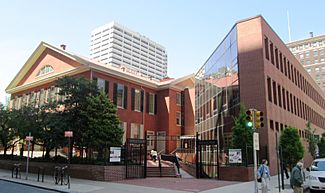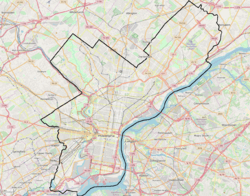Race Street Friends Meetinghouse facts for kids
Quick facts for kids |
|
|
Race Street Meetinghouse
|
|

(2013)
|
|
| Location | 1515 Cherry Street Philadelphia, Pennsylvania, U.S. |
|---|---|
| Built | 1856 |
| NRHP reference No. | 93001610 |
| Added to NRHP | November 4, 1993 |
The Race Street Meetinghouse is a historic building in Philadelphia, Pennsylvania. It is located at 1515 Cherry Street in the city center. This building is a special place for the Religious Society of Friends, also known as Quakers. It has been an active meetinghouse since it was built.
For many years, from 1857 to 1955, it was the main meeting place for a group of Quakers called the Hicksite sect. They held their important yearly meetings here.
Contents
Building History and Design
The Race Street Meetinghouse was built in 1856. It was designed to be a large and useful space. The building is 131 feet long and 80 feet wide. It sits back from Race Street, creating a nice open yard.
The building actually contains two separate meeting rooms. This design allowed different Quaker groups to use the space. Each meeting room was very tall, about 36 feet high. They also had special "youth's galleries" on three sides. Between these two large meeting rooms, there was a three-story section. This part had many rooms for committee meetings and other activities.
A Place for Important Change
The Race Street Meetinghouse played a big role in American history. It was a center for women's involvement in both religion and social change. Many important leaders in the Women's Movement were connected to this meetinghouse.
Leaders for Equality
- Lucretia Mott was a famous leader here. She worked to end slavery. She also fought for women's rights.
- Hannah Clothier Hull was another important person. She worked for peace.
- Alice Paul was also involved with the meetinghouse. She was a leader in the fight for women's right to vote. She also wrote the Equal Rights Amendment. This amendment aimed to give equal rights to all Americans, regardless of gender.
A National Historic Landmark
Because of its important history, the Race Street Meetinghouse was named a National Historic Landmark in 1993. This means it is a very special place in American history. It was recognized for its part in ending slavery. It was also honored for helping women gain the right to vote. Furthermore, it played a role in the civil rights movement.
The Friends Center Campus Today
Today, the Meetinghouse is part of the Friends Center campus. This campus is home to several important Quaker organizations. These include the National Office of the American Friends Service Committee. The Friends World Committee for Consultation is also here. The Philadelphia Yearly Meeting has its offices on campus too. The Greater Philadelphia Chapter of the United Nations Association is also located here.
On the campus, you can also find a copy of a statue by Sylvia Shaw Judson. The statue is of Mary Dyer. She was a Quaker who was martyred in the 1600s. The Friends Meeting Center, a newer building on the campus, was built in 1974.
See also




